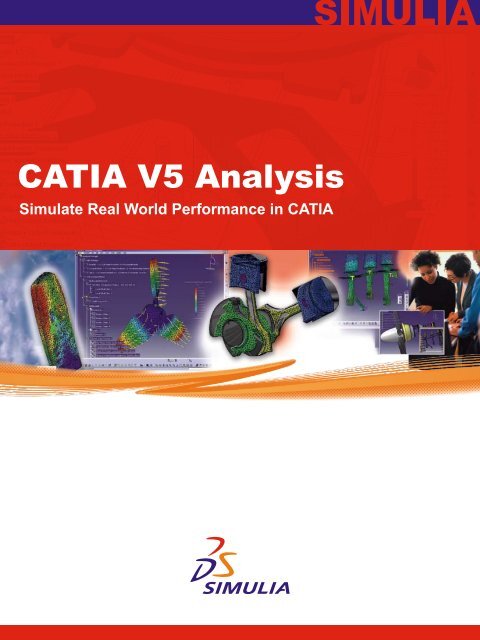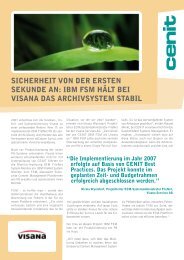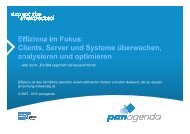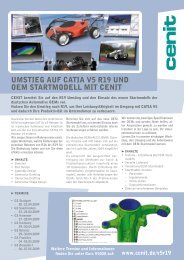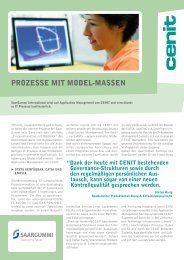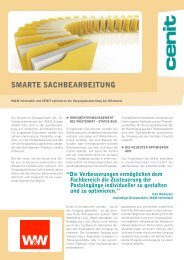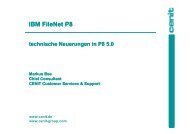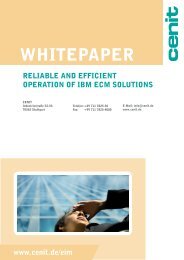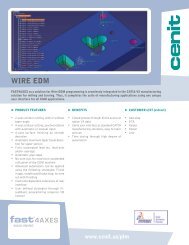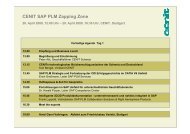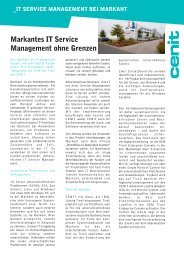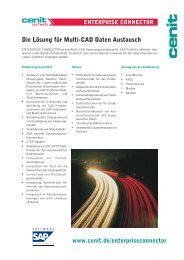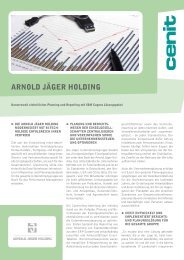CATIA V5 Analysis
CATIA V5 Analysis
CATIA V5 Analysis
Create successful ePaper yourself
Turn your PDF publications into a flip-book with our unique Google optimized e-Paper software.
<strong>CATIA</strong> <strong>V5</strong> <strong>Analysis</strong><br />
Simulate Real World Performance in <strong>CATIA</strong>
Realistic Simulation<br />
in the Design Process<br />
Optimize product performance faster<br />
with integrated design analysis in <strong>CATIA</strong> <strong>V5</strong><br />
Product Development Challenges<br />
Global competition requires the creation of better products<br />
faster and at lower costs—without sacrificing quality. To meet<br />
these challenges, many companies have adopted computeraided<br />
engineering (CAE) to reduce the cost of physical testing,<br />
decrease overall product development time, and improve<br />
understanding of their product performance. Traditionally,<br />
however, CAE has largely been used towards the end of the<br />
development cycle by a limited quantity of highly-qualified<br />
specialists using a standalone product, which has restricted its<br />
effectiveness in the design phase.<br />
For CAE to have a positive impact on product development,<br />
it needs to be used earlier in the design process and allow<br />
designers to explore different design alternatives quickly and<br />
reliably. This requires an integrated CAD/CAE environment that<br />
is easy to use and focused on the needs of the designer.<br />
Your Competitive Advantage<br />
To meet this challenge, SIMULIA provides realistic design<br />
simulation capability within the <strong>CATIA</strong> design environment.<br />
Designers are able to use the familiar <strong>CATIA</strong> user interface and<br />
perform analysis directly on their master reference model in<br />
<strong>CATIA</strong>. Since there is no transfer and translation of geometry,<br />
data integrity issues are avoided. The generative capability of the<br />
<strong>CATIA</strong> <strong>Analysis</strong> product suite allows design-analysis iterations to<br />
be performed rapidly—from simple parts to complex assemblies.<br />
The software leverages the <strong>CATIA</strong> <strong>V5</strong> knowledge-based<br />
architecture, making it easy to optimize designs based on product<br />
performance specifications and analysis results. Unbeatable ease<br />
of use makes <strong>CATIA</strong> <strong>Analysis</strong> particularly suitable for designers<br />
looking to accurately size their designs and quickly evaluate their<br />
real world performance.
Capabilities to Meet the Needs of All Users<br />
• Designers: Use analysis to size parts and ensure that the design will work the first time<br />
• Analysts: Perform a virtual test to evaluate the performance of the design and whether<br />
it will meet its requirements<br />
• Method Developers: Develop standardized analysis methods and then provide those<br />
methods to designers using templates and knowledgeware<br />
Fast <strong>Analysis</strong> Loop<br />
Designers<br />
• Familiar CAD environment<br />
• Geometry associativity<br />
• Automated, adaptive meshing<br />
• Template-based guidance<br />
• Knowledge-based design<br />
optimization<br />
• Computation speed<br />
• Results reliability<br />
<strong>CATIA</strong><br />
<strong>V5</strong><br />
<strong>Analysis</strong><br />
Method Developers<br />
Why Choose <strong>CATIA</strong> <strong>Analysis</strong>?<br />
<strong>CATIA</strong> <strong>Analysis</strong> allows designers who are using <strong>CATIA</strong> to leverage<br />
the power of proven analysis technology to evaluate and improve<br />
their designs. It also provides the technology for engineering<br />
analysts to create complex finite element models while<br />
maintaining associativity with the master design in <strong>CATIA</strong>, thereby<br />
avoiding time-consuming and error-prone transfer of geometry.<br />
Analysts<br />
Detailed <strong>Analysis</strong><br />
• CAD integration<br />
• Rapid model building and results evaluation<br />
• Meshing performance and control<br />
• Easy update after design change<br />
• Large model capacity<br />
• Solver performance and flexibility<br />
• Open to multiple applications<br />
Process Automation<br />
• Knowledge-based architecture<br />
• Capture of analysis methods and knowledge<br />
• Templates to deploy standard analysis methods<br />
“Using <strong>CATIA</strong> <strong>Analysis</strong>, a designer rather than an<br />
expert is now able to perform an analysis on an<br />
automobile transmission gear assembly. In the past,<br />
such an analysis would only take place if serious<br />
problems requiring design modification occurred…<br />
With today’s improved CAE tools, however, all<br />
analysis conditions for the gear assembly can be<br />
set within 30 minutes.”<br />
—Dr. Takanao Uchida, leader of the <strong>CATIA</strong> <strong>V5</strong> project at<br />
Honda Automotive R&D and one of the pioneers of “Designer<br />
CAE” in Japan
Features and Benefits:<br />
• User-friendly environment<br />
• Fast design-analysis loops<br />
• Multidiscipline collaboration<br />
• Knowledge-based optimization<br />
•<br />
Industry-proven performance<br />
User-friendly environment<br />
<strong>CATIA</strong> <strong>Analysis</strong> provides designers and analysts with an<br />
intuitive user interface that meets their varied needs. Since<br />
the user interface is a natural extension of that in <strong>CATIA</strong>, it<br />
is particularly easy for <strong>CATIA</strong> users. They obtain a realistic<br />
understanding of the mechanical behavior by quickly reviewing<br />
design characteristics in a digital mockup (DMU) environment.<br />
The <strong>CATIA</strong> <strong>V5</strong> tools and environment—that are common to all<br />
<strong>CATIA</strong> applications, Abaqus for <strong>CATIA</strong>, and partner solutions—<br />
eliminate the problem of lost productivity associated with using<br />
multiple applications.<br />
Knowledge-based optimization<br />
The <strong>CATIA</strong> <strong>Analysis</strong> products leverage the native <strong>CATIA</strong><br />
knowledge-based architecture. They allow designs to be<br />
optimized by capturing and studying the knowledge associated<br />
with part design and analysis. The reuse of analysis features<br />
and the application of knowledge-based rules and checks<br />
ensure compliance to company best practices. Automation of<br />
standard analysis processes through the use of knowledgeware<br />
templates dramatically improves the efficiency of the designanalysis<br />
process.<br />
Fast design-analysis loops<br />
The analysis specifications are an extension of the part and<br />
assembly design specifications, and the analysis is performed<br />
directly on the <strong>CATIA</strong> geometry. It is, therefore, simple and<br />
convenient to perform an analysis to help size parts and<br />
compare the performance of different design alternatives.<br />
The impact of design changes can be rapidly assessed<br />
with automatic updates. Designers using <strong>CATIA</strong> <strong>Analysis</strong><br />
will naturally use analysis as part of their design process,<br />
affording them a greater understanding of how their designs<br />
perform and improving their ability to deliver the right design<br />
the first time.<br />
Multidiscipline collaboration<br />
<strong>CATIA</strong> <strong>Analysis</strong> supports concurrent engineering, allowing<br />
users to work closely together and avoid rework. Designers<br />
and analysts can collaborate since they have access to the<br />
same environment, eliminating data transfer, rework, and the<br />
need to maintain multiple applications for design and analysis.<br />
The analysis environment also allows method developers to<br />
create templates that designers can routinely use to perform<br />
standard types of analysis.<br />
Industry-proven performance<br />
The speed with which analyses can be performed in <strong>CATIA</strong><br />
often surprises designers and simulation experts familiar with<br />
other applications. The time it takes to create the finite element<br />
model, solve it, and display results can be a matter of minutes.<br />
The robust, built-in finite element solver and mesh generators<br />
balance both accuracy and speed. The adaptive meshing<br />
capability automatically adjusts the mesh to obtain accurate<br />
results without time-consuming manual involvement.<br />
“With <strong>CATIA</strong>, it’s one click to move from design to analysis and then another click to move to NC (Numerical<br />
Control) programming. That’s invaluable because many of our engineers perform all three tasks, and they<br />
only have to learn one user interface. It has cut at least 50% off our development times.”<br />
—Steve Oliver, Director of Design Services, Gillett Evernham Motorsports
<strong>V5</strong> <strong>Analysis</strong> Products<br />
Generative Part Structural <strong>Analysis</strong> (GPS) Generative stress and modal analysis on single parts<br />
Generative Assembly Structural <strong>Analysis</strong> (GAS) Generative stress and modal analysis on hybrid assemblies<br />
Generative Dynamic <strong>Analysis</strong> (GDY) Generative structural dynamic response analysis<br />
ELFINI Structural <strong>Analysis</strong> (EST) Complementary advanced options for preprocessing, solving, and postprocessing<br />
FEM Surface (FMS) Complementary advanced options to generate associative mesh from surface design<br />
FEM Solid (FMD) Complementary advanced options to generate associative mesh from solid design<br />
Nonlinear Structural <strong>Analysis</strong> (ANL) Basic nonlinear and multi-step analysis of parts and hybrid assemblies<br />
Thermal <strong>Analysis</strong> (ATH) Generative thermal analysis of parts and hybrid assemblies<br />
Scalable Solutions<br />
The design analysis suite in <strong>CATIA</strong> provides significant<br />
simulation capabilities including:<br />
• Linear stress analysis on parts and hybrid assemblies<br />
(solid, surface, and wireframe)<br />
• Nonlinear stress analysis on parts and hybrid assemblies<br />
(solid, surface, and wireframe)<br />
• Transient and harmonic dynamic analysis<br />
• Thermal analysis<br />
• Advanced contact analysis<br />
• Buckling analysis<br />
• Thermo-mechanical analysis<br />
• Modal analysis<br />
• Multi-step analysis<br />
• Vehicle assembly analysis<br />
• Assembly of multiple analysis models<br />
• Advanced material behavior including the yielding of metals<br />
and hyperelastic materials like rubber<br />
• <strong>Analysis</strong> of composites<br />
It also has the ability to integrate with other SIMULIA products<br />
such as Abaqus, which offers even more advanced capability like<br />
impact analysis, material failure, and fluid-structure interaction.<br />
Partner products provide <strong>CATIA</strong>-integrated analysis solutions for<br />
many other applications like multi-body dynamics, computational<br />
fluid dynamics, fatigue analysis, and stamping analysis.
JAN_CAT_Y09<br />
About SIMULIA<br />
SIMULIA is the Dassault Systèmes brand that delivers a scalable portfolio of Realistic Simulation solutions including the Abaqus product suite for Unified Finite Element <strong>Analysis</strong>,<br />
multiphysics solutions for insight into challenging engineering problems, and SIMULIA SLM for managing simulation data, processes, and intellectual property. By building on<br />
established technology, respected quality, and superior customer service, SIMULIA makes realistic simulation an integral business practice that improves product performance,<br />
reduces physical prototypes, and drives innovation. Headquartered in Providence, RI, USA, SIMULIA provides sales, services, and support through a global network of regional<br />
offices and distributors.<br />
For more information, visit www.simulia.com.<br />
The 3DS logo, <strong>CATIA</strong> and SIMULIA are registered trademarks of Dassault Systèmes or its subsidiaries. Other company, product, and service names may be trademarks or service marks of their respective owners.<br />
Copyright Dassault Systèmes, 2009<br />
SIMULIA World Headquarters<br />
166 Valley Street<br />
Providence, RI 02909 USA<br />
+1 401 276 4400<br />
E-mail: simulia.info@3ds.com<br />
www.simulia.com


